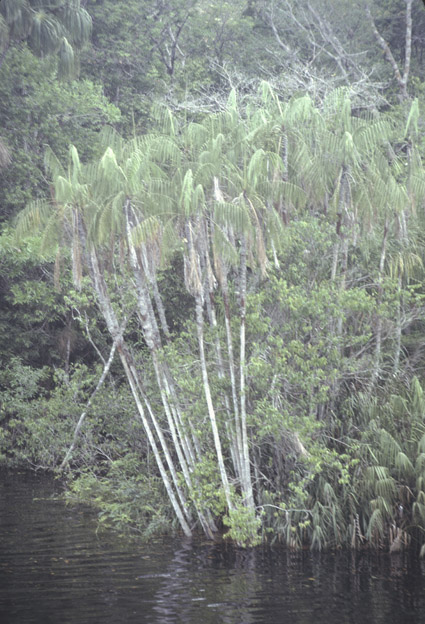- Acanthophoenix
- Acrocomia
- Actinokentia
- Actinorhytis
- Adonidia
- Aiphanes
- Allagoptera
- Ammandra
- Aphandra
- Archontophoenix
- Areca
- Arenga
- Asterogyne
- Astrocaryum
- Attalea
- Bactris
- Balaka
- Barcella
- Basselinia
- Beccariophoenix
- Bismarckia
- Borassodendron
- Borassus
- Brassiophoenix
- Burretiokentia
- Butia
- Calamus
- Calyptrocalyx
- Calyptrogyne
- Calyptronoma
- Carpentaria
- Carpoxylon
- Caryota
- Ceratolobus
- Ceroxylon
- Chamaedorea
- Chamaerops
- Chambeyronia
- Chelyocarpus
- Chuniophoenix
- Clinosperma
- Coccothrinax
- Cocos
- Corypha
- Cryosophila
- Cyphokentia
- Cyphophoenix
- Cyphosperma
- Daemonorops
- Deckenia
- Desmoncus
- Dictyocaryum
- Drymophloeus
- Dypsis
- Elaeis
- Eleiodoxa
- Eremospatha
- Eugeissona
- Euterpe
- Gaussia
- Geonoma
- Guihaia
- Hedyscepe
- Hemithrinax
- Howea
- Hyophorbe
- Hyospathe
- Hyphaene
- Iriartea
- Iriartella
- Itaya
- Jailoloa
- Johannesteijsmannia
- Juania
- Jubaea
- Jubaeopsis
- Kentiopsis
- Kerriodoxa
- Korthalsia
- Laccospadix
- Laccosperma
- Lanonia
- Latania
- Lemurophoenix
- Lepidocaryum
- Lepidorrhachis
- Leucothrinax
- Licuala
- Linospadix
- Livistona
- Lodoicea
- Lytocaryum
- Manicaria
- Manjekia
- Marojejya
- Masoala
- Mauritia
- Mauritiella
- Maxburretia
- Medemia
- Metroxylon
- Myrialepis
- Nannorrhops
- Nenga
- Neonicholsonia
- Neoveitchia
- Nephrosperma
- Normanbya
- Nypa
- Oenocarpus
- Oncocalamus
- Oncosperma
- Orania
- Oraniopsis
- Parajubaea
- Pelagodoxa
- Phoenicophorium
- Phoenix
- Pholidocarpus
- Pholidostachys
- Physokentia
- Phytelephas
- Pigafetta
- Pinanga
- Plectocomia
- Plectocomiopsis
- Podococcus
- Pogonotium
- Ponapea
- Prestoea
- Pseudophoenix
- Ptychococcus
- Ptychosperma
- Raphia
- Ravenea
- Reinhardtia
- Retispatha
- Rhapidophyllum
- Rhapis
- Rhopalostylis
- Roscheria
- Roystonea
- Sabal
- Sabinaria
- Salacca
- Saribus
- Satakentia
- Satranala
- Schippia
- Sclerosperma
- Socratea
- Solfia
- Sommieria
- Syagrus
- Synechanthus
- Tahina
- Tectiphiala
- Thrinax
- Trachycarpus
- Trithrinax
- Veitchia
- Verschaffeltia
- Voanioala
- Wallaceodoxa
- Wallichia
- Welfia
- Wendlandiella
- Wettinia
- Wodyetia
- Zombia
- x Jubautia splendens
- ?? Acoelorrhaphe
- ?? Bentinckia
- ?? Brahea
- ?? Clinostigma
- ?? Colpothrinax
- ?? Copernicia
- ?? Cyrtostachys
- ?? Dictyosperma
- ?? Dransfieldia
- ?? Heterospathe
- ?? Hydriastele
- ?? Iguanura
- ?? Incertae sedis & excluded names
- ?? Loxococcus
- ?? Micronoma
- ?? Paripon
- ?? Pritchardia
- ?? Rhopaloblaste
- ?? Serenoa
- ?? Washingtonia

Distribution
From 1°50'N-1°05'S and 62°42'-69°20'W in the upper Rio Negro region of Brazil (Amazonas) and Venezuela (Amazonas) at (80-)98(-130) m elevation along the margins of black water rivers where the bases of the stems are underwater for several months of the year. Leopoldinia major appears to have a very patchy distribution (possibly a result of insufficient collecting); in Brazil it is known only from two localities along the Rio Negro, near Barcellos and near Santa Isabel; in Venezuela only along the Ríos Pasimoni-Yatua-Baria; and possibly the Río Papurí on the Colombian-Brazilian border. It may also occur on the Río Casiquiare; one specimen (Putz 179), not mapped, is labeled as coming from there but lacks a precise locality. (Henderson, A.J., A revision of Leopoldinia (Arecaceae) in Phytotaxa 32. 2011)A
Discussion
- Taxonomic notes: - Because of the ambiguity of the lectotype, a drawing by Wallace, an epitype is here designated. One specimen (Acevedo 8026) has the rachis length given on the label as 250 cm, but this is considered unlikely and the measure is excluded. A sterile specimen (Luetzelburg 23047) from the "Rio Papori" along the Colombian-Brazilian border is tentatively included here, based on its leaf sheath apex.
Leopoldinia major differs from L. pulchra in its short, loose, separating leaf sheath fibers; pendulous pinnae; broad pinnae bases without swellings; dimorphic inflorescences, and obovoid fruits with smooth surfaces or with obscure, non-reticulate ridges from mesocarp fibers.
Subspecific variation: - Given the confusion over the identity of Leopoldinia major in southern Venezuela (see Introduction), it is unfortunate that so few specimens from this region give any information on stem branching or pinnae aspect. Only one specimen (Steyermark 102454) describes these ("in colonies... leaves with drooping, subcoriaceous pinnae"). There is an image for a second specimen (Gentry 47344 at http://www.tropicos.org/) showing pendulous pinnae, but this is unclear on stem branching. However, one other specimen (Putz 179) is confusing in that the stems are reported to be "solitary (?)". This specimen is said to come from the Río Casiquiare, where no other specimens are known. (Henderson, A.J., A revision of Leopoldinia (Arecaceae) in Phytotaxa 32. 2011)A
Description
- Plants (5.0-)6.8(-8.0) m tall; stems height and diameter no data, clustered.
Leaves (10-)11(-12) per stem; sheaths 23 cm long, fibers from apices short, loose, separating, not joined; petioles (65.0-)71.0(-77.0) cm long; rachises (52.5)-56.5(-59.0) cm long, (4.4-)5.5(-7.2) mm diameter; pinnae (12-)13(-14) per side of rachis, pendulous, the bases broad, not narrowed, without swellings, midveins scarcely raised in cross-section adaxially; basal pinna 41.5 cm long, (0.2-)0.4(-0.8) cm wide, forming an angle of 69° with the rachis; apical pinna (22.5-)24.3(-26.0) cm long, (0.6-)1.1(-1.5) cm wide, forming an angle of 7° with the rachis.
Inflorescences dimorphic; prophylls no data; peduncular bracts no data, inserted (6.0-)8.5(-11.0) cm above the prophyll; peduncles 26.0 cm long, (10.0-)15.4(-20.4) mm diameter; staminate rachillae (0.6-)1.2(-2.0) cm long; pistillate rachillae (10.5-)13.2(-18.0) cm long; fruits (33.6-)40.4(-45.5) mm long, (28.1-)33.2(-39.2) mm diameter, flattened, obovoid in side view, the surfaces smooth or with obscure, non-reticulate ridges from mesocarp fibers. (Henderson, A.J., A revision of Leopoldinia (Arecaceae) in Phytotaxa 32. 2011)A
- Log in to post comments

